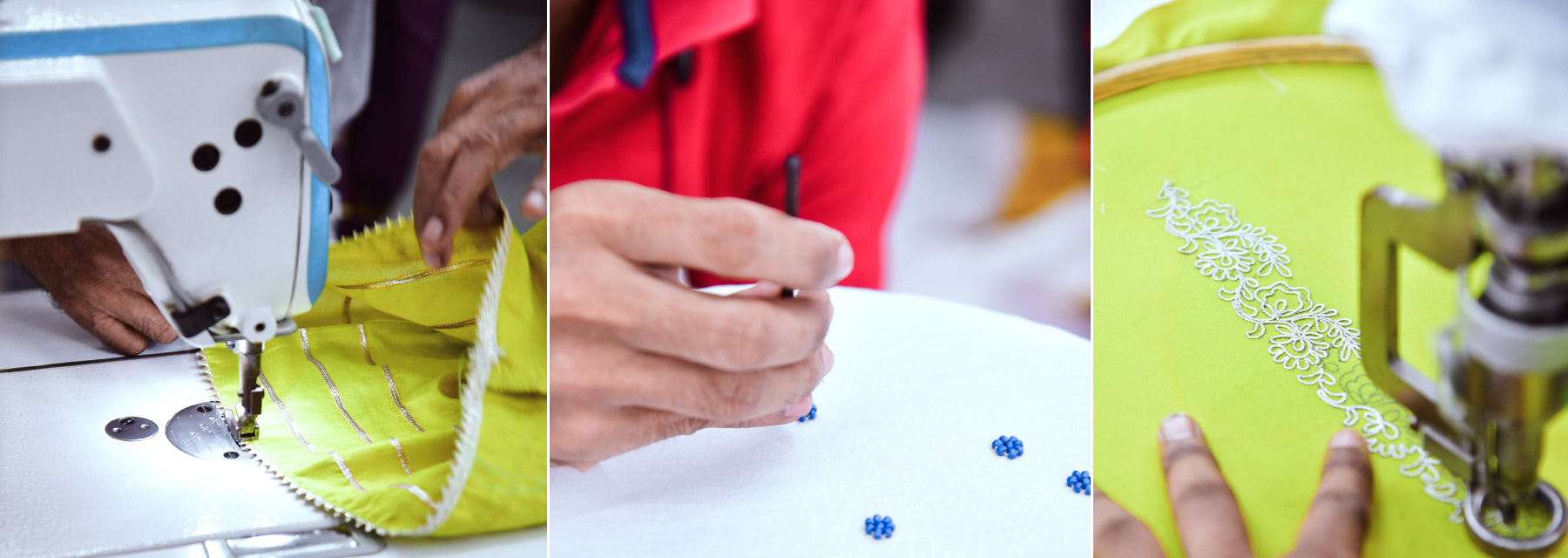Introduction
Embroidery is an old art that has been used for thousands of years to make plain fabric look lively and beautiful. Today, when we think of ethnic wear, intricate embroidery patterns come to our mind. As technology progresses, there has been a silent battle between the traditional hand-embroidered designs and machine embroidery designs. In the world of ethnic wear, does the machine stand tall, or is there an irreplaceable charm in the touch of a human hand? Let’s dive into the thoughts of hand vs. machine embroidery.
Check: 6 Types Of Different Ethnic Wear Fashion Style To Follow 2023
Traditional Embroidery Techniques
Historically, embroidery was a testament to patience, creativity, and skill. Every region had its signature style, each stitch telling its own tale. Think of the delicate 'Chikankari' from Lucknow, or the vibrant 'Kantha' stitch from Bengal – every thread woven with tales of the locale. The human touch was not just evident but was a prized possession of the cloth.
Modern Embroidery Technologies
In a new era, machines have taken over tasks once carried out by human hands. In the world of embroidery, machines brought precision, speed, and replicability. Ethnic wear saw a surge of designs, patterns, and styles. What took a craftsman days or even weeks to create, a machine could replicate in mere hours.
Check: The Intricate Craftsmanship of Hand Block Printing: A Journey Through Art
Comparing the Craftsmanship
Precision & Uniformity:

Precision of Machine Embroidery wins hands down when it comes to precision and uniformity. With computerized design inputs, machines can reproduce intricate designs without a single misstep.
Speed & Volume:

There's no debate here – machines can produce in bulk and at a speed incomparable to human hands. This not only brings down costs but also meets the high demands of the fashion industry.
Personal Touch & Uniqueness:

Hand embroidery takes the crown in this category. Each handcrafted piece is unique, bearing subtle differences from another. This lends an exclusivity to the wearer, a feeling that they are donning a piece of art.
Versatility:

While machines are designed to handle a variety of threads and patterns, there’s a certain versatility in handwork. Craftsmen can improvise on the go, intertwining threads of different textures and thicknesses, something that might be challenging for a pre-programmed machine.
Cost Comparison in Embroidery:

Hand-embroidered pieces, given the time and skill they demand, tend to be pricier. They are often considered luxury items. Machine-embroidered wear, due to its bulk production capabilities, is often more pocket-friendly.
Check: Navratri Outfit Ideas: What to Wear for the Navratri Festival 2023
Hand embroidery V/s Machine embroidery
The Emotional Connect
Beyond the physical attributes of the embroidery, there’s an emotional dimension to consider. Hand-embroidered ethnic wear often carries the soul of the artisan. The time, effort, and emotions invested in each piece resonate with many wearers. Artistry of Handcrafted Embroidery will always have a story, a lineage and a legacy.
Machine embroidery, though beautiful and intricate, may lack this narrative. It’s more about mass production and less about personal tales.
Conclusion
Harmonizing Hands and Machines at Nero
At Nero, the debate between hand vs. machine in the realm of ethnic wear embroidery is transcended. Instead of ranking one above the other, we embrace the strengths and values of both. Our brand believes that while hand-embroidered pieces offer wearers an irreplaceable charm and a profound connection to cultural roots, machine embroidery, on the other hand, brings intricate designs to many at an accessible price.
Our commitment goes beyond mere craftsmanship. It's an ethos that intertwines tradition with innovation. Envision a future where machines lay the groundwork with large-scale base designs and skilled artisans interweave their magic, adding those finishing touches that breathe life into a garment. This harmonious blend of efficiency and emotion is the dance of threads and tech that we champion. Nero epitomizes a commitment to authentic clothing, sustainable practices, and the unparalleled artistry of hand block printing, hand embroidery, and machine embroidery. Each garment we craft is a testament to the rich cultural heritage of India, meticulously crafted by artisans specializing in age-old techniques. Inspired by nature's beauty, our designs are more than just clothing; they are stories – tales of the past, present, and an ever-evolving future.
Check: Celebrate Culture and Style with NERO INDIA: A Journey through Exceptional Ethnic Fashion
FAQs
Q1: Why is hand embroidery better than machine embroidery?
Ans: Hand embroidery offers a unique, personal touch to each design. Machine embroidery, while precise, might lack the artisanal charm and individuality of handwork.
Q2: What is the difference between hand embroidery and traditional embroidery?
Ans: Hand embroidery refers to designs created manually by artisans using needles, while traditional embroidery encompasses age-old, culturally specific stitching techniques, which can be done by hand or machine.
Q3: What is the history of hand and machine embroidery?
Ans: Hand embroidery dates back millennia, with ancient civilizations using it for adornment. Machine embroidery emerged with the industrial revolution, bringing scale and precision.
Q4: What is the difference between computer embroidery and machine embroidery?
Ans: Computer embroidery uses digital designs and software-driven machines for precision, while machine embroidery can refer to any mechanized process, including older methods without computer integration.



